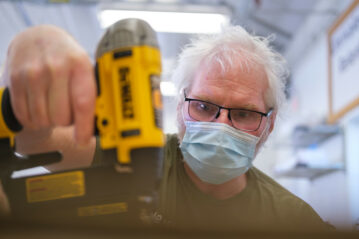Tom Borgaila arrives at the QLI Maintenance Workshop three minutes before his appointment begins. He comes through the door in his wheelchair—half-scooting himself forward heel-first, and half-pushed by a Life Path Services assistant helping him between buildings. It’s still early March, after all, and the weather hasn’t yet taken its early spring turn.
His stark white hair stands up at points like cotton fiber stretched to thin ends. It gives him the appearance of some chair-bound mad scientist. Restless, punctual, always in motion whether physical or otherwise.
That sensibility serves him well in the shop, where woodworking projects wait in temporary pause and the walls are lined with shelved parts and industrial tools and the various bits and bobs necessary to keep QLI running. He’s met here by Mike Bose, one of QLI’s maintenance team members. The two happen to be longtime friends and fellow craftsmen. They trade quick jokes about their years shooting the breeze around backyard firepits.
“Oh, yeah,” Mike says. “We used to get into trouble.”
Then he corrects his posture and raps Tom on the shoulder.
“But not too much trouble, am I right?”
Tom responds, laughing wheezily: “Right. Not too much trouble.”
Mike leads Tom, still scooting along in his wheelchair, to their corner of the workshop. An unfinished hardwood chest sits on a pallet dolly. Tom wakes his iPad and scrolls past an image of his grandchildren to snap a picture. This chest is theirs, a handmade home for toys and numerous games. He’s made it himself in his months at QLI, from design to construction.
Today, he’s coating it in primer.
“Do you want a smock?” Mike asks. Tom shakes his head, waving the question off.
“I’m not messy like you. I know what I’m doing.”
They laugh at the barb before Mike says, “Yeah, I hear they call that ‘perfectionism.’”
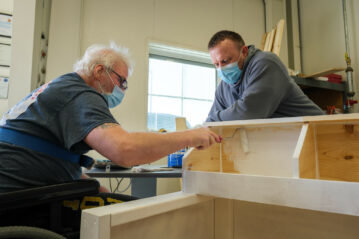
Near the end of the session, Mike reveals to Tom’s accompanying Life Path Services assistant that the chest has a hidden convenience. The top-mounted shelves lift from the boxframe for simple transport. Clever construction keeps them in place when fully assembled. When the time comes to deliver the gift to his grandchildren, Tom will be able to do so with relative ease.
Mike regards the design—and the designer—with admiration.
“It’s brilliant. Give him enough time and I believe Tom can build anything.”
—
The question with traumatic brain injury isn’t ‘How do you build?’, but rather, how does a person rebuild. By what process does a person transform what was into what can still be.
Tom was forced to face that question in August 2020, when an unhelmeted motorcycle accident changed everything about the 59-year-old’s life. He’d been a devoted grandfather, a lifelong craftsman, an upstanding neighbor, a revered friend, and an avid motorcycle rider. But the myriad effects of the crash—not only the injury to his brain, but overwhelming spinal and skeletal damage, too—threw all of that past life out of focus.
Brain injuries are unique in their invisibility. Broken bones set in casts. Or they are grafted anew with titanium reinforcements. Bruises dull over time.
To a degree, this is true for the brain as well. But injuries to the brain leave behind, in the most literal sense of the word, a disconnect. A blockage that prevents the brain’s messages from reaching the necessary parts of the body.
Where a brain injury’s presence sometimes seems intangible, the symptoms it leaves behind are obvious. Often, painfully so.
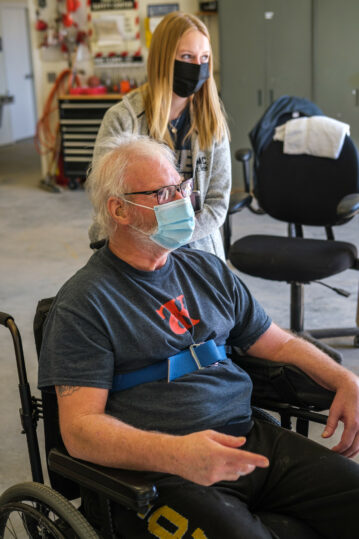
He suffered from left-sided hemiparesis—a term used to describe partial paralysis and generalized weakness in his left arm and left leg. He couldn’t walk as he’d used to, or even safely stand without extraordinary assistance. And his arm hung slack at his side, though most of the time it was fixed into proper orientation by a padded brace he wore each day.
The injury affected the function of his throat and airways, too. Swallowing foods or even thin liquids was too demanding a task. When he spoke, he did so in whispered, clipped statements—just a few words before his breath was gone.
A passerby can see the effect that change has had on Tom. It’s a summary written in the language of strain, visible in the sheer effort and singular intent he exerts to perform even mundane actions.
Consider how easy it was to bend down and slip into your pant legs this morning, or the strength you need to ease yourself into a chair, or the complex synchronicity of your mouth and nose and throat when you swallow a bite of a meal, the very tandem effort that prevents you from choking.
It’s a level of detail so very far removed from everyday concern.
And yet for Tom, these finer aspects were always top of mind. Each day, each hour, dedicated to doing just a little more.
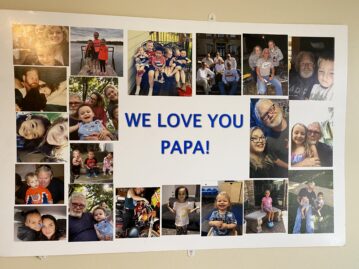
Indeed, progress is what Tom has made.
At QLI, Tom’s recovery requires a unique tack. Rather than tell Tom how to perform an action and correct mistakes as they occur, his clinicians orchestrate situations that eliminate the possibility for error altogether, creating through repetition a kind of habitual success.
This strategy is perhaps most readily apparent in his daily physical therapy sessions, where each morning Tom participates in a battery of gait training exercises. Sometimes his mornings look rather ordinary. The days when he walks on a treadmill, for instance. But often, these sessions task Tom with scaling or descending a staircase, forcing him to stress the sleepy, still-recovering muscles of his impaired left leg.
In every case, his training sessions include a therapist—frequently, multiple therapists—on close standby. Using their hands, they make consistent manual adjustments to his upright posture, to the roll of his shoulders, to the clean step-through of his shortened stride. They maintain these positions while he walks, as if molding clay to retain a specified contour. Slowly, over time, the assistance decreases. The adjustments hold. Tom maintains the correct positioning almost implicitly.
It’s with this extraordinary attention to detail that Tom takes thousands of steps each week. Up stairs, down stairs, along corridors, through the length of his on-campus house to lunch and the same length back to his private room.
After months keeping this pace, he graduates to advanced training.
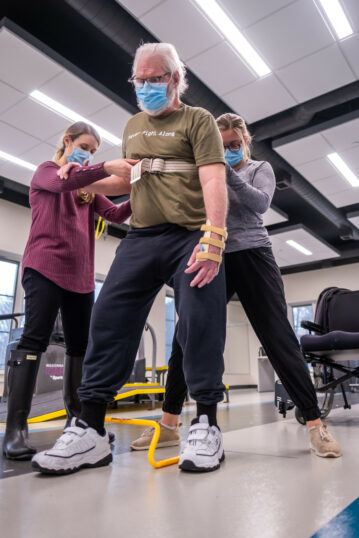
But it’s clear this is no dance. Tom clenches his jaw with each movement, forcing air out through pursed lips. The fatigue and residual pain become too much to bear after a handful of repetitions. He can’t keep his bodyweight on the left leg for long.
Rachel gives him a little leeway.
“You can use the cane for the rest of the reps,” she says, still watching his balance even as he stands on two feet. “I want to be sure you get the practice.”
She says this because the practice is what got him here in the first place. Here, on his way to walking without any help whatsoever. Here, from being locked in a wheelchair months ago—when it wasn’t certain he’d have any path forward.
Life at QLI is like this in all respects. Even in the on-campus residence, quality repetition matters most. It provides the connective tissue his brain needs to bridge the gap.
“At this point, we’re not ruling out independent living,” says Aubrey Nickell, Tom’s speech-language pathologist. “In fact, we’re building his skill set in order for him to get there.”
He’s seven months removed from the accident, and with Aubrey’s tutelage Tom has gone from a no-food-by-mouth restriction to eating small solids, ingredients chopped into palatable cubes—a testament to how strong the muscles governing his swallowing function have become. She uses a mix of regular exercise and electric stimulation to bolster his progress.
“Think of it like weightlifting for your throat,” she says. “Being able to swallow correctly plays such a huge part in a person’s moment-to-moment safety. Not to mention their independence while eating.”
But in the house, the training challenges his mind, too. Like the physical therapy, Tom’s cognitive practice leans more on implicit learning than explicit study-and-recall. Where one targets the stabilizer muscles necessary for walking, the other stimulates the parts of the brain governing memory and creative reasoning.
Aubrey supervises Tom through a recipe—Philly Cheesesteaks, one of his favorites.
“My daughters don’t like it when I cook this,” Tom says. He cuts a wry, knowing smile. “But that’s okay. Just means more for me.”
Aubrey is Tom’s shadow. She’s watchful of his movements, ready to intervene at the first sign of an accident with a sharp object or a hot cooktop. But, mostly, her role is that of an initiator.
“What are you doing first,” she asks.
“Prepping the veggies,” Tom says.
“And what do you need?”
“Knife and cutting board,” Tom says. This is a difficult balance, but Tom is managing well. He’s cooked this dish a hundred times, but this is his first attempt after injury—and with one good hand, no less. So when the adaptive cutting board comes out of the cupboard, its tiny food spikes meant for holding the food in place, Tom doesn’t miss a beat. He drives an onion onto the spikes and starts slicing with care.
It isn’t long before Tom has all of the food prepared—the onions, the peppers, the small slices of red meat. These are steps he knows like the back of hand, and some he’s simply practiced enough with Aubrey. Soon, he’s over the stovetop. The house smells of cooked bell pepper and seasoned salt. Multiple residential team members poke their head into the kitchen, joking with Tom about stealing his lunch before he gets the chance to eat it.
In time, Tom’s rehabilitation team expects him to manage his meal plan from the ground up, as he will need to do when he eventually departs from QLI and lives independently in the community.
But Tom has time. And in light of his continued progress, his team has confidence.
“These are foundational steps for Tom,” Aubrey says. “But you look at what he’s doing, how he’s recovered in terms of reasoning and problem solving ability—this is really encouraging. He’s come a long way. He’s on his way to doing so much more.”
—
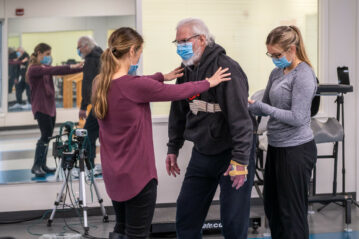
It’s a long road. But Tom is unconcerned. Just as did while rolling primer on the wood, he understands the value of calmness. It’s easy to look forward to the other side of recovery, a return to the halcyon days when he can get back on the bike and ride with the crew down to Daytona Beach.
But he’s in no rush.
“I’ve got time,” he says. “I’m getting better. I can really feel I’m getting better. But it’s all work. Got to put the work in.”
Weeks have gone by at the QLI Maintenance Workshop. The toy chest is unrecognizable, no longer a boxframe and panels coated waiting to be painted. Tom has started to lay the finishing touches—gray base color, the sides a brilliant blue and red. He snaps a picture with his iPad and jokes about how his grandkids will have to divide the space for their individual toys.
By now, his white hair has grown long enough to comb back away from his forehead. Mike kneels at the foot of Tom’s wheelchair and comments on the look.
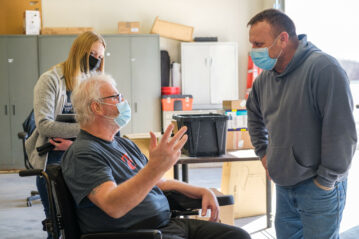
“I’m feeling good,” Tom says. He eyes the chest, and it’s clear, even despite the surgical mask covering his face, that he’s smiling. Hard work bears results. He can see the truth of that sitting right there in front of him, right there on the wheeled pallet.
His recovery will be a process that stretches far beyond QLI. For the rest of his life, he’s likely to see little jumps of forward motion. Things here and there that grow better and easier than he remembered. But, for the time being, his lone focus is on assembling the scattered pieces of his life and crafting them into a greater sum.
“Are the therapists working you pretty hard,” Mike asks. Tom laughs, a gesture that itself serves as a kind of confirmation.
“Oh, yeah,” he says. “Yeah, they’re working me hard. But I’m not waving no white flag. Let’s keep this thing going.”
Categories: Brain Injury, Client Story

